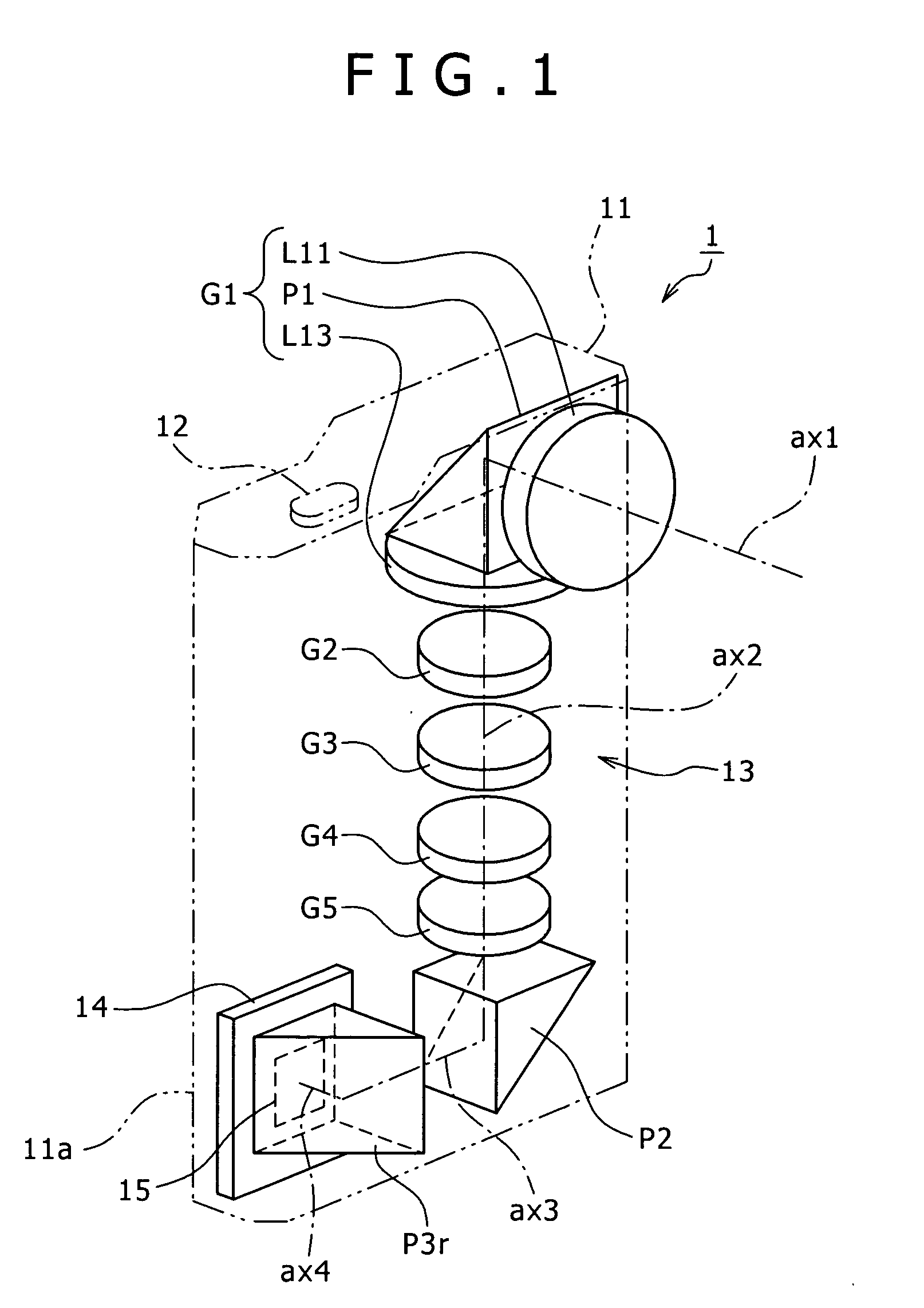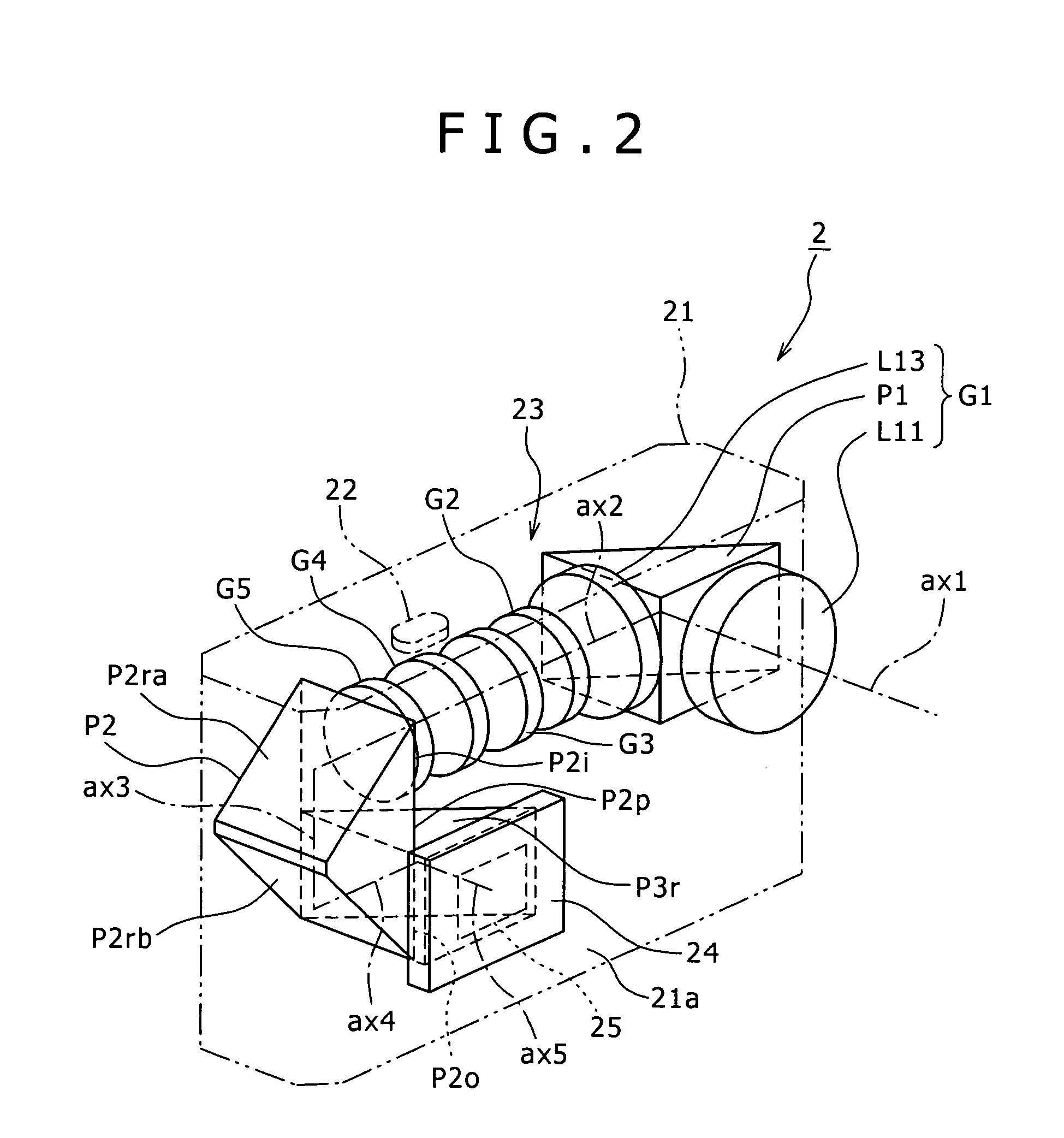Image capture apparatus and zoom lens
a technology of image capture and zoom lens, which is applied in the field of image capture apparatus and zoom lens, can solve the problems of unfavorable folding length of the lens barrel, inability to obtain high-quality images in terms of noise, and large-sized and heavyweight, and achieves high image quality, high image quality, and high image quality
- Summary
- Abstract
- Description
- Claims
- Application Information
AI Technical Summary
Benefits of technology
Problems solved by technology
Method used
Image
Examples
first embodiment
[0047] The construction of the optical system 13 in the image capture apparatus 1 will be described below with reference to FIG. 1. The zoom lens 13 includes, in the following order from an object side, the first lens group G1 which is made of a negative lens group L11 having the first optical axis (the entrance optical axis) ax1, the first prism P1, and a positive lens group L13 having a second optical axis ax2 folded downward approximately 90 degrees by the prism P1, a second lens group G2 (corresponds to the movable lens group) which has negative refractive power and moves along the optical axis to mainly perform a zooming action, a third lens group G3 (corresponds to the fixed lens group) which is fixed on the optical axis and has positive refractive power, a fourth lens group G4 (corresponds to the fixed lens group) which has positive refractive power and performs focusing as well as correction of variations of an image forming position due to power variations, and a fifth len...
second embodiment
[0049] The construction of the optical system 23 in the image capture apparatus 2 will be described below with reference to FIG. 2. The zoom lens 23 includes, in the following order from the object side, the first lens group G1 which is made of the negative lens group L11 having the first optical axis (the entrance optical axis) ax1, the first prism P1, and the positive lens group L13 arranged on the second optical axis ax2 folded laterally approximately 90 degrees by the prism P1, the second lens group G2 which has negative refractive power and moves along the optical axis to mainly perform a zooming action, the third lens group G3 which is fixed on the optical axis and has positive refractive power, the fourth lens group G4 which has positive refractive power and performs focusing as well as correction of variations of an image forming position due to power variations, and the fifth lens group G5 which is fixed on the optical axis and has negative refractive power, the second len...
third embodiment
[0051] The construction of the optical system 33 in the image capture apparatus 3 will be described below with reference to FIG. 2. The zoom lens 33 includes, in the following order from the object side, the first lens group G1 which is made of the negative lens group L11 having the first optical axis (the entrance optical axis) ax1, the first prism P1, and the positive lens group L13 arranged on the second optical axis ax2 folded laterally approximately 90 degrees by the prism P1, the second lens group G2 which has negative refractive power and moves along the optical axis to mainly perform a zooming action, the third lens group G3 which is fixed on the optical axis and has positive refractive power, the fourth lens group G4 which has positive refractive power and performs focusing as well as correction of variations of an image forming position due to power variations, and the fifth lens group G5 which is fixed on the optical axis and has negative refractive power, the second len...
PUM
 Login to View More
Login to View More Abstract
Description
Claims
Application Information
 Login to View More
Login to View More - R&D
- Intellectual Property
- Life Sciences
- Materials
- Tech Scout
- Unparalleled Data Quality
- Higher Quality Content
- 60% Fewer Hallucinations
Browse by: Latest US Patents, China's latest patents, Technical Efficacy Thesaurus, Application Domain, Technology Topic, Popular Technical Reports.
© 2025 PatSnap. All rights reserved.Legal|Privacy policy|Modern Slavery Act Transparency Statement|Sitemap|About US| Contact US: help@patsnap.com



